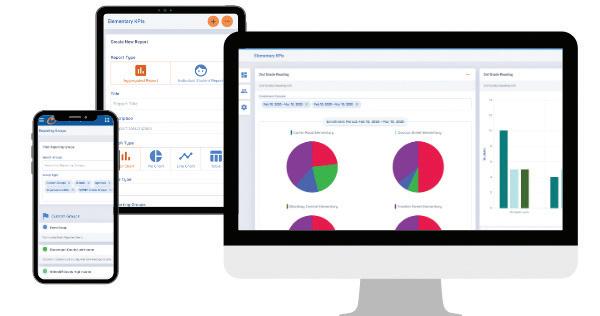
8 minute read
COMET Informatics Collaborating For Rochester's Children
Everyone knows collaborating with your community will create better outcomes for the children you serve. Sharing is caring...right?
by Andrew Remillard and Samantha Lape
Taking all of the information, demographics, living situation, academic performance, outside of school time program attendance, ketchup or mustard on a hot dog preference, and creating a 360-degree view of every child in your community can only bring good things. There is one slight hiccup in the plan. It's hard. Like really hard. Speed bumps like multiple data collection sources, consents, and willingness to participate can feel like unclimbable mountains.
The good news is the wave of cooperation is spreading. The reality of better outcomes, less duplication of services, and the better use of resources and broader access to funding sources are becoming less of a rumbling and more of a conversation. There are great examples of collaboration brewing in our local communities. The coming together of schools, community-based organizations, and for-profit entities to provide improved services helps create a more resilient system to support our children.
More Than Just "Absent" Or "Present"
In April, the Rochester City School District (RCSD) and COMET 4 Children (COMET) expanded their collaboration with the Children's Institute led Rochester Early Childhood Assessment Partnership (RECAP) to develop a custom attendance module specifically for the distance learning environment created in response to the Corona Virus pandemic. Due to the existing (expansive and impressive) child-centric collaboration structure in Rochester (see image to the right), this software was developed and in the "hands" of teachers within days.
Ann Marie White, Executive Director of Children's Institute, describes why this technology supports the wellbeing of children in Rochester. "During this pandemic, families with young children have faced crises on many fronts, as daily supports for their children's health, education, growth, and enrichment became remote. Despite these massive COVID-19-related disruptions, Rochester's universal pre-K system of school- and community-based providers has continued to partner with parents to support each child and family's wellbeing. Pre-school professionals work daily to connect in new and meaningful ways with families' children as they shelter in place at home. We are pleased to support this system of caring educational contacts between pre-school professionals and families during this crisis. This new record system we commissioned and designed with partners will help pre-school teachers and programs continue to forge high quality supports across early childhood education programs even during such difficult times for all."
COMET programmed this custom attendance software commissioned for RECAP to allow RCSD Pre-K teachers to
10
| The ROCHESTER ENGINEER SEPTEMBER 2020 cover article
track distance learning sessions. The software was live within a week (from requirements through production) due to consistent communication and instant feedback. Thanks to this collaborative effort, distance learning users now have customization options that allow Schools, OutOf-School-Time (OST's), and Community Based Organizations (CBO's) to track contacts by customizable parameters such as Livestream (group or individual), phone call, text, email, no contact, etc. to track and report interactions with their kids.
Dr. Robin Hooper, Executive Director of the Office of Early Childhood at the Rochester City School District, praised the work of COMET and the staff, "In these unprecedented times, where the lives of our youngest students and their families have been so upended, we much appreciate the fast, thoughtful work the COMET team provides for our students, their families, our classrooms and our staff. Over the years, we have counted on COMET in times of unusual need; and to date, they have always come through to support our work with families and students."
"The children in our community needed us to step up, and we did," says Leonard Gingello, COMET CEO. "We worked very hard to develop this technology with our partners at RCSD and Children's Institute in a very short period of time because we believe in the work being done every day in our community using collaborative data to improve outcomes for our children."
Building Blocks of Successful Community Collaborations
Our experience in the for-profit software development space has yielded a unique perspective on what it takes to create a successful collaboration. Being the data collection software for a few collaborations around the country has helped us understand the key areas which lead to a smoother start and more reliable information exchange.
cover article

In no particular order, here are the foundational blocks we see the most thriving communities are built on:

1. Purpose
To paraphrase some wise puppets, "purpose is the spark that lights the flame under your…" You get the point. The purpose of a collaborative community lies beyond the walls of a specific out-of-school-time group or community-based organization. For some communities, it's rooted in systemic change. For some, it's a singular problem like graduation rate, immunization rate, or access to quality child care. The answer lies within your community and the groups who are willing to entertain the idea of collaboration. Having and communicating a clear purpose will not only help other organizations get on board but also help you see the light at the end of the tunnel shine a little brighter when you're stuck in an endless number of meetings hashing out the details of consent or minimum data set requirements. Reality is, in most communities, a single child can be enrolled with multiple organizations. Without a full view of that child, it's almost impossible to see what interventions worked to improve their life, let alone understand what other children might be traveling down the same trajectory where a simple intervention could make a similar impact. You know this. You're passionate about this. Please don't lose sight of it.
Continued on page 12...
SEPTEMBER 2020 The ROCHESTER ENGINEER | 11
2. Stakeholder Engagement Plan
Anyone who has spent any time with kids will agree a child will be more willing to participate when they directly benefit from the "So, what?" It turns out, organizations that help kids are very similar. In very few instances, it happens organically. A round table discussion leads to (virtual) handshakes and (socially-distanced, air) high-fives, and everyone runs back to their headquarters to get the data sharing consents signed. It is more likely you will meet with some like-minded community members, and the rumble to collaborate will start with a small group looking to do great things. Collaboration (like getting your kids to pick up their room) will be far more likely to happen if there is a dedicated plan to make sure the groups who would benefit are strategically engaged from the beginning. A plan like putting a primary school principal on a Kindergarten Readiness team. A plan like engaging the head of pediatrics in your local health system for your early childhood screening and intervention program. Making a smart, strategic plan will help smooth the path toward the ultimate goal.

3. Leadership
Although your whole community is coming together to make a bigger and better impact, someone needs to own the effort. Between deciding votes on critical topics, data quality assurance, and consent guidance, your community will need to have an arbiter who will keep the overall purpose of everyone involved. That role can come in many forms from funders, CBOs, advocacy organizations, or government entities. It certainly isn't the easiest position to hold, but with a strong sense of purpose and excellent stakeholder engagement, you won't be standing alone.
4. Flexibility in Data Collection
From million-dollar custom platforms to handwritten attendance entered into a Google Sheets document, every organization has its way of collecting data. Coupled with funder mandated collection and reporting platforms, to launch a community-wide collaboration with yet another data system that creates a second, third or fourth place to enter little Susie's attendance at day camp will create a collaborative mutiny before you email off your first report. Finding a platform that can play well with all of the agencies involved and not require them to change their already effective and ingrained system is critical. Experience has shown me eliminating the hassles of data collection will pay dividends when it comes to overall buy-in from the organizations you are looking to include in your effort.
Our current climate has shown a spotlight on issues in every community. The good news is there has never been a better time to start planning a community-wide collaboration. Sharing resources with like-minded partners, reducing duplication and unnecessary hurdles through thoughtful planning leads to meeting the needs of the kids in realtime, coming together as a community, in the truest sense of the word, and is more critical now than ever. Like all things in life, if it were easy, you'd already be doing it. Make a plan. Share that plan. Make your community a better, healthier, more inclusive place to live. www.comet4children.com | info@comet4children.com | 585.673.3200 Stay updated on our work in Rochester and subscribe to our newsletter.
Andrew Remillard, COMET Informatics Sales & Marketing Manager Samantha Lape COMET Informatics Communications & Public Relations Manager
12
| The ROCHESTER ENGINEER SEPTEMBER 2020 cover article

More Than Just "Absent" Or "Present" In April, the Rochester City School District (RCSD) and COMET 4 Children (COMET) expanded their collaboration with the Children's Institute led Rochester Early Childhood Assessment Partnership (RECAP) to develop a custom attendance module specifically for the distance learning environment created in response to the Corona Virus pandemic. Due to the existing (expansive and impressive) child-centric collaboration structure in Rochester (see image to the right), this software was developed and in the "hands" of teachers within days.
The good news is the wave of cooperation is spreading. The reality of better outcomes, less duplication of services, and the better use of resources and broader access to funding sources are becoming less of a rumbling and more of a conversation. There are great examples of collaboration brewing in our local communities. The coming together of schools, community-based organizations, and for-profit entities to provide improved services helps create a more resilient system to support our children.
Taking all of the information, demographics, living situation, academic performance, outside of school time program attendance, ketchup or mustard on a hot dog preference, and creating a 360-degree view of every child in your community can only bring good things. There is one slight hiccup in the plan. It's hard. Like really hard. Speed bumps like multiple data collection sources, consents, and willingness to participate can feel like unclimbable mountains.






